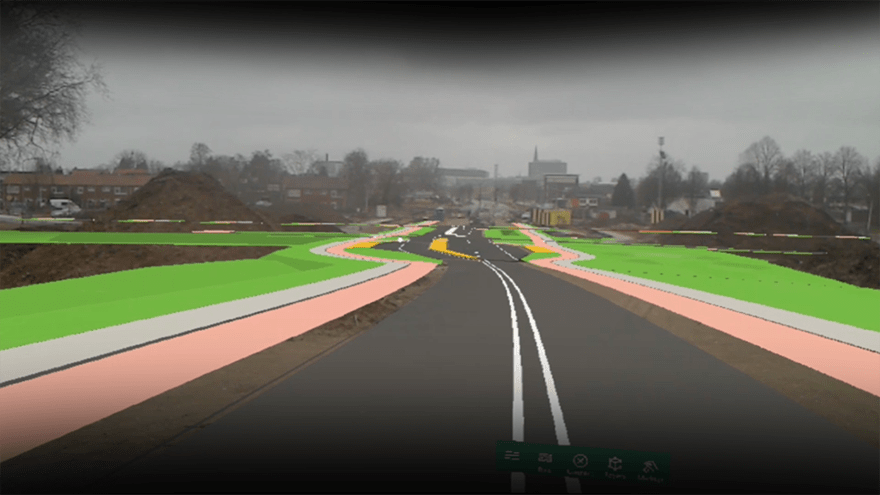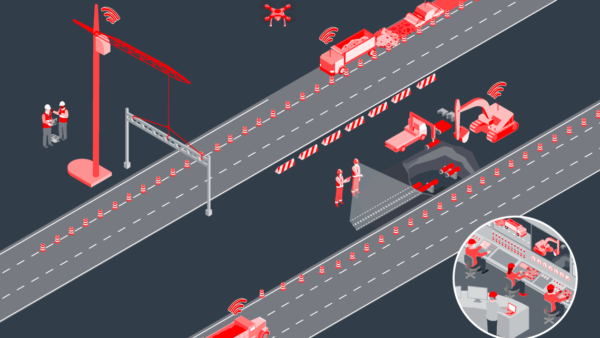Dutch construction and engineering firm Dura Vermeer has developed a mixed reality helmet that exploits motion-tracking technology used in bodysuits worn by actors in the production of Hollywood animated films to improve their accuracy.
The firm worked with augmented reality software developer Recreate to develop the EBMR (Engineering Building Mixed Reality) helmet, which is a regular construction helmet fitted with a Microsoft HoloLens headset.
The system is fitted with a satellite receiver that identifies the user’s location on site and an Xsens sensor that tracks their physical orientation and heading information. This enables a user to visualise detailed architectural plans, including building structure and components as holograms overlaid onto their regular view of a building site. Holograms are anchored into position, even when the user walks around a project.
Dura Vermeer trialled EBMR during construction of a major bridge in The Netherlands, resulting in time and quality benefits. André van der Vegt, regional manager for the Eastern Netherlands at Dura Vermeer, told BIM+: “We wanted to give our workers, site managers and project leaders an experience of what they had to build so they could see complex details, potential conflicts and so deliver a better quality project.
“Users can walk through the model, see underground cables and the height and location of the bridge, which helped us work out where to place cranes and materials etc. It is possible to switch on and off different layers, such as foundations and piles, and different layers of structure for the bridge to make the holograms easy to understand.”

Dura Vermeer trialled EBMR during construction of a major bridge in The Netherlands
The EMBR helmet was developed to overcome the challenges associated with traditional 2D drawings or computer renderings of an architect’s plan, which are abstract and require skill and judgement on the part of building professionals to interpret them, potentially leading to error, miscalculation or miscommunication between members of a project team.
A GNSS receiver mounted at the top of the helmet provides accurate positioning coordinates, and an Xsens inertial measurement unit (IMU), mounted on the rear, provides orientation and heading information, including the direction the user is facing and the position of the head, known as pitch, roll and yaw.
An extremely sensitive magnetometer, or magnetic compass, mitigates the risk of magnetic interference from other electronics systems.
“HoloLens normally needs to be in a room to know where it is, to make it function effectively outside we created the connection to GPS and added the IMU ‘compass’ so the helmet always understands where it is,” says van der Vegt.
Xsens has previously been used in movie production as well as by automotive companies to record the movements of crash test dummies.
The software from Recreate fuses the information in 2D drawings with real-time positioning and orientation information from the IMU and the GNSS receiver to project a holographic image in HoloLens that exactly maps onto the viewer’s perspective in both horizontal and vertical planes.
In field trials, visualisations of building designs have proved accurate enough to be used instead of professional surveying equipment. “The addition of GPS makes this more advanced than other augmented reality systems, it enables us to pin down the location to 1cm to 2cm accuracy,” says van der Vegt. Construction crews have said the helmet is comfortable enough to be worn for long periods, he adds.
Dura Vermeer is currently working with Recreate to develop a second prototype with an improved user interface for construction workers and more refined hardware.
“The first version worked well, but it had some problems with the wiring, we experienced some errors outside because the wires disconnected, or the battery went down. The new version will be more robust and we will produce more units to roll out to projects,” concludes van der Vegt.












